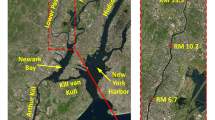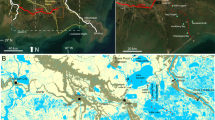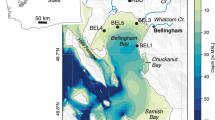Abstract
Analysis of moored and shipboard hydrographic data along with suspended sediment data is used to provide the first comprehensive description of the dynamics and sediment transport processes of the Passaic River. The river has been highly depositional since dredging ceased in the 1940s and within this sedimentary record are high levels of contaminants including high levels of dioxins. Moored current meter data indicates that during low freshwater discharge both tidal period and residual flows favor a landward sediment flux. In contrast during moderate to high river flows the salt field is washed out of the system and results in a net downstream sediment flux that overcome the more persistent but weaker upstream flux during low river flow conditions. Consequently, with today’s channel morphology the Passaic exports sediment to Newark Bay that we estimate is approximately equal the annual loadings. This, together with historical bathymetric surveys, suggests that the channel is approaching geomorphological equilibrium. Bathymetric changes in the Passaic River over the past 60 years have significantly altered the river's ability to trap sediments and contaminants and are consistent with the fact that most of the dioxins released to the river in previous decades appear to be trapped within the channel, despite the fact that they were released within a tidal excursion of the mouth. The decline in trapping efficiency is also consistent with a simple scaling analysis that suggests that the salt water intrusion length, and thus the ability to trap sediment, scales with the cube of the channel depth. Consequently, as the estuary shoaled its ability to trap sediments and contaminants diminished rapidly.
















Similar content being viewed by others
References
Bopp, R.F., M.L. Gross, H. Tong, H.J. Simpson, S.J. Monson, B.L. Deck, and F.C. Moser. 1991. A major incident of dioxin contamination: sediments of New Jersey estuaries. Environmental Science & Technology 25(5): 951–956.
Chant, R.J., and R.E. Wilson. 2000. Internal hydraulics and mixing in a highly stratified channel. Journal of Geophysical Research 105(C6): 14215–14222.
Dyer, K.R. 1986. Coastal and estuarine sediment dynamics. Chichester: John Wiley & Sons.
Dyer, K. 1988. Fine sediment particle transport in estuaries, 295–310. Springer-Verlag: Physical Processes in Estuaries. D. a. v. Leussen.
Friedrichs, C. 1995. Stability shear stress and equilibrium cross-sectional geometry of sheltered tidal channels. Journal of Coastal Research 11(4): 1062–1074.
Friedrichs, C. (2010). Barotropic tides in channelized estuaries. In Contemporary issues in estuarine physics, ed. Valle-Levinson, 27–61. Cambridge England: Cambridge University.
Friedrichs, C.T., and D.G. Aubrey. 1988. Non-linear tidal distortion in shallow well-mixed estuaries: a synthesis. Estuarine, Coastal and Shelf Science 27: 521–545.
Friedrichs, C.T. and D.G. Aubrey. 1995. Uniform bottom shear stress and equilibrium hypsometry of intertidal flats. In Mixing processes in estuaries and coastal seas, ed. C. Pattiaratchi, 1–25. Washington, D.C.: American Geophysical Union.
Geyer, W.R. 1993. The importance of suppression of turbulence by stratification on the estuarine turbidity maximum. Estuaries 16(2): 113–125.
Geyer, W.R., J.H. Trowbridge, and M.M. Bowen. 2000. The dynamics of a partially mixed estuary. Journal of Physical Oceanography 30: 2035–2048.
Hansen, D.V., and M. Rattray. 1966. New dimensions in estuary classification. Limnology and Oceanography 11: 319–326.
Huntley, S.L., R.J. Wenning, S.H. Su, N.L. Bonnevie, and D.J. Paustenbach. 1995. Geochronology and sedimentology of the lower Passaic River, New Jersey. Estuaries 18(2): 351–361.
Jay, D.A., and J.D. Musiak. 1993. Internal tidal asymmetry in channel flows: origins and consequences. Washington DC: American Geophysical Union.
Jay, D., W. Geyer, R. Uncles, J. Vallino, J. Lagier, and W. Boynton. 1997. A review of recent developments in estuarine scalar flux estimation. Estuaries 20(2): 262–280.
Klingbeil, K.D., and C.K. Sommerfield. 2005. Latest Holocene evolution and human disturbances of a channel segment in the Hudson River Estuary. Marine Geology 218: 135–153.
Lerczak, J.A., W.R. Geyer, and R.J. Chant. 2006. Mechanisms driving the time-dependent salt flux in partially stratified estuary. Journal of Physical Oceanography 36(12): g2283–2298.
Lurie, N.M. and M. Mappen. 2004. Encyclopedia of New Jersey, Rutgers University Press.
MacCready, P. 1999. Estuarine adjustment to changes in river flow and tidal mixing. Journal of Physical Oceanography 12: 708–726.
MacCready, P. 2004. Toward a unified theory of tidally-averaged estuarine salinity structure. Estuaries 27(4): 561–570.
Monismith, S.G., W. Kimmerer, J.R. Burau, and M.T. Stacey. 2002. Structure and flow-induced variability of the subtidal salinity field in northern San Francisco Bay. Journal of Physical Oceanography 32(11): 3019–3032.
Powers, C.W., G.R. Munoz, and R.A. Panero. 2006. Pollution prevention and management strategies for dioxins in the New York/New Jersey Harbor. New York Academy of Science, New York: 259.
Ralston, D.K., W.R. Geyer, and J.A. Lerczak. 2008. Subtidal salinity and velocity in the Hudson River estuary: observations and modeling. Journal of Physical Oceanography 38(4): 17.
Steinberg, N., D.J. Suszkowski, L. Clarc, and J. Way. 2004. Health of the Harbor: the first comprehensive look at the state of the NY/NJ Harbor estuary. N. Y. N. J. H. E. Program. New York City: 86.
Winterwerp, J.C. 2001. Stratification effects by cohesive and noncohesive sediment. Journal of Geophysical Research 106: 22,559–22,574.
Acknowledgments
This work was funded by a grant from the New Jersey Department of Transportation. We are grateful for the dedicated work of Elias Hunter and Chip Haldeman who lead the mooring efforts and for Tim Wilson for running the TSS samples. We also thank Carl Friedrichs for his thorough, insightful and constructive criticism of an earlier draft of this manuscript.
Author information
Authors and Affiliations
Corresponding author
Rights and permissions
About this article
Cite this article
Chant, R.J., Fugate, D. & Garvey, E. The Shaping of An Estuarine Superfund Site: Roles of Evolving Dynamics and Geomorphology. Estuaries and Coasts 34, 90–105 (2011). https://doi.org/10.1007/s12237-010-9324-z
Received:
Revised:
Accepted:
Published:
Issue Date:
DOI: https://doi.org/10.1007/s12237-010-9324-z




